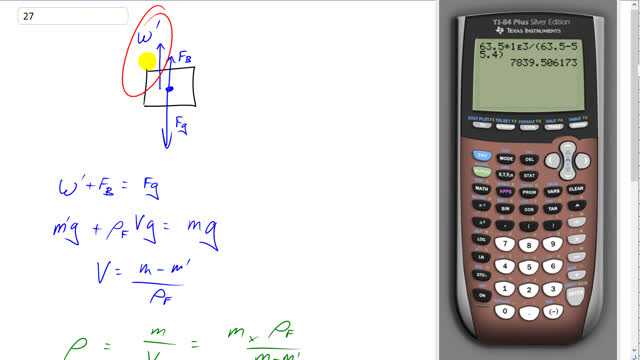
What is the likely identity of a metal (see Table 10–1) if a sample has a mass of 63.5 g when measured in air and an apparent mass of 55.4 g when submerged in water?

In order to watch this solution you need to have a subscription.
This is Giancoli Answers with Mr. Dychko. When this metal is submerged in water, there are two forces upwards: one is the buoyant force equal to the weight of the water displaced; and the other is the apparent weight or the tension exerted by some spring scale that's holding it up and then there's this gravity downwards on the metal sample as well. So the total up forces have to equal the total down forces when this thing is stationary and so the apparent weight up plus the buoyant force up equals the weight down which is mg and the buoyant force upwards is the mass of water displaced times g to give the weight of water displaced. So that's the density of water— I have written ρ F for 'fluid' here— times the volume of the piece of metal which is also the volume of water displaced because the metal is totally submerged and then we have the apparent mass times g to give the apparent weight. And we'll solve this for V because then we can find the density of the material by going mass divided by the volume. So the g's cancel everywhere and then we take this m prime to the right side by subtracting it from both sides so this gives m minus m prime and then afterwards divide by the density of the fluid—density of water in this case— so that gives the volume of this thing. And then its density, which is how we'll identify it, because we'll look at this table [10-1] on page 261 and look at the densities there and we take the mass multiplied by the reciprocal of the volume— instead of dividing by a fraction, we'll multiply by its reciprocal— so we are taking mass times density of the fluid divided by the true mass minus the apparent mass and the true mass is 63.5 grams, sort of. I say sort of because this is the mass measured in air and technically that's also affected by the fact that there's a buoyant force upwards due to the air but the density of air is so small compared to the density of water and compared to the density of the material, it's gonna have no significant effect. So we can consider this to be the mass in a vacuum, the true mass. So we have 63.5 grams times density of water—1.00 times 10 to the 3 kilograms per cubic meter— divided by 63.5 grams minus 55.4 grams and that gives 7840 which appears to be iron or steel when you look at this table of densities on page 261.